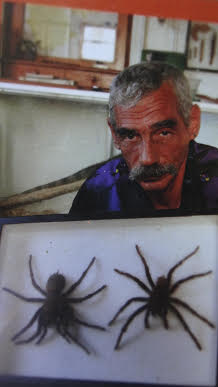Theraphosa apophysis
| Pinkfoot goliath | |
|---|---|
| Scientific classification | |
| Domain: | Eukaryota |
| Kingdom: | Animalia |
| Phylum: | Arthropoda |
| Subphylum: | Chelicerata |
| Class: | Arachnida |
| Order: | Araneae |
| Infraorder: | Mygalomorphae |
| Family: | Theraphosidae |
| Genus: | Theraphosa |
| Species: | T. apophysis
|
| Binomial name | |
| Theraphosa apophysis (Tinter, 1991)[1]
| |
| Synonyms[1] | |
|
Pseudotheraphosa apophysis Tinter, 1991 | |

Theraphosa apophysis is a
Description
Theraphosa apophysis generally resembles
The female specimen on which the species was described had a total body length of 87 mm (3.4 in), with the longest leg (the fourth) being 96 mm (3.8 in) long. The male had a somewhat smaller body, with a total length of 80 mm (3.1 in), and slightly longer legs, the fourth being just under 100 mm (3.9 in) long.[5]
Taxonomy
The species was first described by Andreas Tinter in 1991, as Pseudotheraphosa apophysis.[1] Tinter purchased an individual under the name "Pamphobeteus exsul", but realized that it could not be correctly named, as it possessed stridulatory organs. After further investigation, he named it as a new species in a new genus, Pseudotheraphosa.[5] In 2001, based on a phylogenetic analysis, Rogério Bertani rejected this genus and placed the species in Theraphosa,[6] a view followed since by other workers.[1]
In captivity
Theraphosa apophysis is considered to be a difficult tarantula to care for and maintain, and is therefore not recommended for beginners.[4] This is due to their nervous and defensive disposition, as well as high humidity requirements. However, their large size, food-aggressiveness, and fast growth rate make them desirable for more experienced keepers.
References
- ^ a b c d e "Taxon details Theraphosa apophysis (Tinter, 1991)", World Spider Catalog, Natural History Museum Bern, retrieved 2016-05-19
- ^ Bern, Natural History Museum. "NMBE - World Spider Catalog". wsc.nmbe.ch. Retrieved 2024-03-19.
- ^ a b Peters, H.-J. (2003), "Theraphosa apophysis (Tinter, 1991)", Tarantulas of the World: Amerika's Vogelspinnen (in German), Wegberg, Germany: H.-J. Peters, p. 298
- ^ a b http://spacechickinscaresheets.blogspot.com/2008/04/pinkfoot-goliath-tarantula-theraphosa.html[unreliable source?]
- ^ a b Tinter, A. (1991), "Eine neue Vogelspinne aus Venezuela Pseudotheraphosa apophysis n. gen. n. sp. (Araneae: Theraphosidae: Theraphosinae)", Arachnologischer Anzeiger (in German), 16: 6–10
- ^ Bertani, R. (2001), "Revision, cladistic analysis, and zoogeography of Vitalius, Nhandu, and Proshapalopus; with notes on other theraphosine genera (Araneae, Theraphosidae)", Arquivos de Zoologia, 36: 265–356
